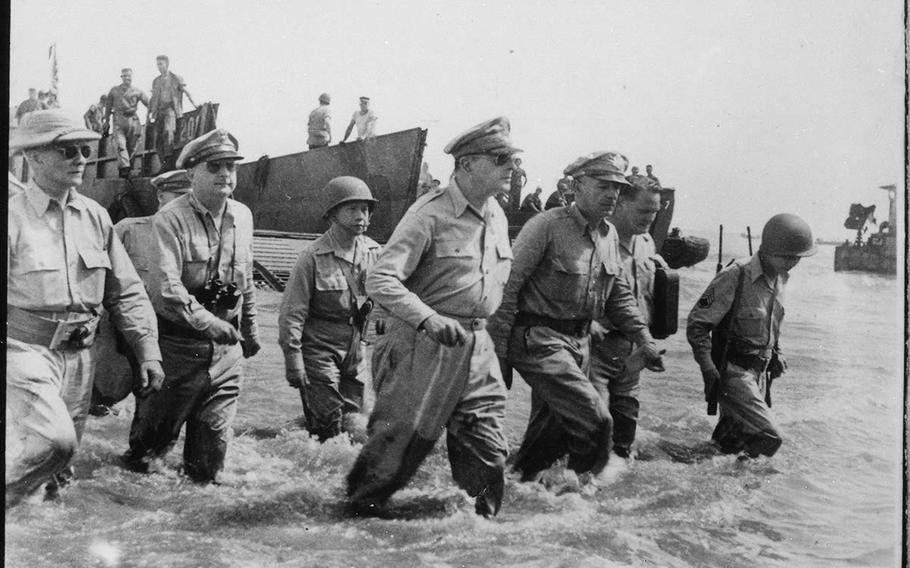
Army Gen. Douglas MacArthur wades ashore during initial landings at Leyte, Philippines, in October 1944. (National Archives )
Researchers will soon have digital access to the morning reports of Army units during the final year of World War II, offering descriptions of unit locations, award nominations and soldier personnel movements.
The records transferred to a digital format include tens of thousands of morning reports sent during 1945 that exist now on microfilm at the National Archives facility in St. Louis, Mo., and focus on personnel updates at the company, battalion and brigade level. The project, which also includes more than a decade’s worth of post-war draft registration cards, was announced this year as part of a partnership with Ancestry, a private company specializing in genealogy research. All records will be available to the public and were not previously available online.
“They are one of our most popular collections — very highly used on site and requested from around the world,” said Theresa Fitzgerald, director of the personnel records division for National Archives in St. Louis. “They have become an important part of reconstruction and military research.”
Much of that value comes from the detailed information available about personnel updates and the physical location of the unit at the time that the report was written. That value increased after a 1973 fire at the National Archives Personnel Records Center destroyed more than 16 million military personnel files from 1912 to 1964, which has made it difficult for some veterans and their families to prove their service history to receive benefits.
.jpg/alternates/PORTRAIT_350/Morning%20reports%20Jan%2022%201945%201.jpg)
An Army morning report from Jan. 22, 1945, that was transferred from microfilm to a digital format through a partnership between the National Archives and the company Ancestry. The entire year’s worth of reports will soon be available online and offer researchers information about a unit’s personnel updates during the final year of World War II. (National Archives)
More than 100,000 microfilm reels of morning reports were rescued from the burning building, according to the National Archives.
Using the reports, Fitzgerald said researchers can track a veteran from the date that they joined a particular unit to the date that they left it.
“If they switch units, which was very common, that would be noted in the morning reports, and you would stop your research with that unit and go to the new one,” she said.
Some even describe smaller battles that occurred or notes about the weather, the geographical surroundings, encounters with wildlife, or they list the towns that troops traveled through.
The unit’s clerk would type the reports onto long strips of paper and send them in batches to the Army, she said. The Army used this form of morning reports until 1974 when it switched to a system of personnel data cards. The Navy and Marine Corps kept similar records but in large diaries as opposed to individual papers.
Once this round of records is transferred to a digital format, full sets of morning reports from 1944 through 1946 will be available online, said Quinton Atkinson, senior director of global content acquisition for Ancestry, which has partnered with the National Archives to transfer records since 2008.
“These reports are significant, both in their specificity and in the larger historical context they were created under,” he said.
The second piece of military records included in the latest Ancestry partnership includes nearly 10 million draft registration cards from 1948 to 1959. The cards are another popular collection because each one provides the registrant’s basic information as well as an address, occupation, a basic physical description and the person’s chosen beneficiary.
“These are pretty standard,” Fitzgerald said. “But I’ve found over the years that some of the interesting ones are usually when you come across famous people, or infamous people.”
Once the process is complete, the records will be available to access through the National Archive website archives.gov.
Above: An example of more than a decade’s worth of draft cards that will soon be available online through a partnership between the National Archives and the company Ancestry. The cards can help researchers, particularly genealogy researchers, because they include a man’s address, job, marital status and sometimes a physical description. Photo provided by the National Archives.